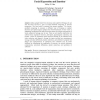Free Online Productivity Tools
i2Speak
i2Symbol
i2OCR
iTex2Img
iWeb2Print
iWeb2Shot
i2Type
iPdf2Split
iPdf2Merge
i2Bopomofo
i2Arabic
i2Style
i2Image
i2PDF
iLatex2Rtf
Sci2ools
AIHC
2007
Springer
2007
Springer
Foundations of Human Computing: Facial Expression and Emotion
Many people believe that emotions and subjective feelings are one and the same and that a goal of human-centered computing is emotion recognition. The first belief is outdated; the second mistaken. For humancentered computing to succeed, a different way of thinking is needed. Emotions are species-typical patterns that evolved because of their value in addressing fundamental life tasks. Emotions consist of multiple components, of which subjective feelings may be one. They are not directly observable, but inferred from expressive behavior, self-report, physiological indicators, and context. I focus on expressive facial behavior because of its coherence with other indicators and research. Among the topics included are measurement, timing, individual differences, dyadic interaction, and inference. I propose that design and implementation of perceptual user interfaces may be better informed by considering the complexity of emotion, its various indicators, measurement, individual differences...
| Added | 12 Aug 2010 |
| Updated | 12 Aug 2010 |
| Type | Conference |
| Year | 2007 |
| Where | AIHC |
| Authors | Jeffrey F. Cohn |
Comments (0)

